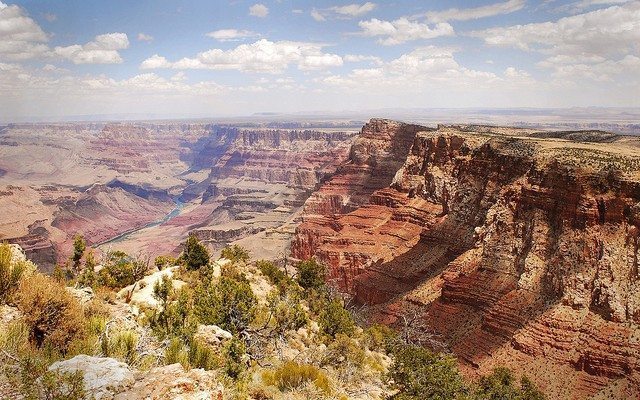 Image courtesy of [Grand Canyon National Park/Kristen M Caldon]
Image courtesy of [Grand Canyon National Park/Kristen M Caldon]
Energy and Environment
Tramway and Restaurants in the Grand Canyon? Stop the Escalade
Laying eyes upon it for the first time, I was ashamed of myself for the image I had conjured up previously. Learning about the Grand Canyon, I envisioned a very large crack in the Earth with a river at the bottom. That sounds impressive, and I was happy to have the opportunity to come visit in person. But when I finally arrived, I was blown away by how, well, grand the Grand Canyon really is. It’s not just a crevice, but a complex. The snaking Colorado River has carved an unprecedented masterpiece into the Southwestern landscape, a transcendental experience for one’s eyes. From the top of the Canyon, the faint whisper of the wind provides joy to one’s ears as well, and from the bottom of the Canyon, riding the Colorado River, the soaring red and orange towers instill in one’s heart a sense of timelessness. But all these emotional evocations may be under threat by the poisonous sight of commercialism and the droning sounds of machines, as a proposal to build a tramway down the Canyon, complete with shops and restaurants, is gaining strength.
The Grand Canyon Escalade is a proposal for a slew of hotels, restaurants, and shops, the epicenter of which is a gondola that would take visitors to the bottom of the Canyon where they can patronize a restaurant, Indian cultural center, and a riverwalk. Especially considering that the base of the tram would not technically be in the Grand Canyon Park, but on Navajo land, some members of that tribe are excited for the proposal and its potential to generate jobs and revenue for the Nation. It would be a productive collaboration between the Navajo people, developers, and the government, all of which may profit from the project.
Yet the proposed site for the base of the tram is at a place called the Confluence, where the Colorado River is met by a smaller tributary, aptly named the Little Colorado. For many Navajo, this place is sacred. They come here to pray, seek spiritual peace, and connect with their ancestors. Building a noisy, gaudy eyesore here would literally be sacrilege; desecration of a temple. Furthermore one must not forget that there are other Native tribes who have been living in the area for millennia, such as the Hopi, who also have religious connections to the site. Their voices are stifled in this debate, as the Navajo are the ones who control the area.
The debate teeters back and forth. Some say that it would ruin the aesthetics, others that it would not be visible from the nearest lookout point. Some say that it would damage the ecosystem, others that the area is already popular among hikers and rafters. Most of all, as previously mentioned, some say that it would economically benefit the Navajo, others that it infringes on existing Navajo practice.

The Colorado continues to carve the Canyon to this day. Courtesy of Hut Slut via Flickr.
How might this tram affect the ways that we think about and experience the Grand Canyon? Defenders have argued that it would enable tourists to experience the Canyon in new ways, and open up opportunities for people for whom the Canyon might otherwise be inaccessible. But there are already ways for people who are not hikers or rafters in peak physical condition to experience the Canyon. If you can stomach the smell, you can ride a mule to the bottom. If you are not phased by the surprisingly high rate of crashes, you can take a helicopter ride through. And of course, the Rim trails are paved and wide enough to accommodate wheelchairs.

A mule train on the Canyon trails. Courtesy of Al_HikesAZ via Flickr.
Casually riding a tram would detract from the experience of the Canyon, not add to it. I would love to see what the world looks like at the summit of Mount Everest. But nobody specifically dreams of simply standing at the top, right? In fact, most climbers only spend a few minutes there. The whole point is to climb the mountain. That is the real challenge and experience of Mount Everest, and that is what makes standing at the top so rewarding, valuable, and coveted. Imagine if there was a tram on which you could ride to the summit? Or a specially designed helicopter or plane that could drop you down on the top? It would certainly be a pretty view, but the experience would be hollow. You would not have earned your right to stand there. As it is, there has been much debate and criticism over the last 20 years regarding the commercialization of climbing Mount Everest. As long as you have the money to spare–about $65,000–any hack can hire a guide and crew who will attempt to get him to the summit. It is this respect and reverence for nature that continues to dwindle in the face of technology and modernization that we must endeavor to preserve.
Throughout modern human history, and particularly since the Industrial Revolution, we have sought to “tame nature,” to regulate, control, master, and rise above it. This has proven to have severe environmental and social consequences.Of late, there have been attempts to reemphasize aesthetics and naturally occurring phenomena. The Grand Canyon fits squarely into this issue. It is a complicated structure that should not necessarily be accessible from all vantage points. We can see and experience it to a very substantial degree but, like Mount Everest, the very inaccessibility, danger, and mystery is what provides it with its mystique and appeal. It is these things that allow it to be a Grand Canyon, and not a tourist-laden crack in the Earth with a river at the bottom.








Comments